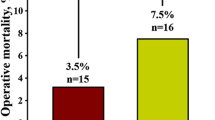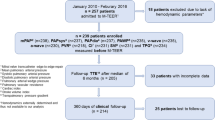Abstract
Persistent pulmonary hypertension (P-PH) after mitral valve replacement (MVR) leads to an increased risk of morbidity and mortality. We sought to determine which factors were involved in its occurrence. Patients undergoing MVR for a 3-year period were collected in a retrospective way. We excluded those with an available follow-up shorter than 3 months. Sample size was 111 patients. PH was diagnosed if systolic pulmonary artery pressure (sPAP) estimated by Doppler echocardiography was >40 mmHg. Clinical, echocardiographic, and surgical factors were analyzed. P-PH was present in 42.3 % of patients after 12.6 months of mean follow-up. P-PH was more frequently observed in elderly and female patients, in those with severe degrees of PH before surgery, and significant tricuspid regurgitation (TR). On multivariable analysis, significant TR (OR 1.739; p = 0.01) and more severe degrees of PH before surgery (OR 1.761; p = 0.03) were significantly associated with the presence of P-PH after MVR. Surgical factors related to P-PH were prosthesis size and tricuspid annuloplasty: no need for the performing of tricuspid annuloplasty (OR 0.345; p = 0.025) and the implantation of a smaller prosthesis (OR 0.656; p = 0.004) were related to higher rates of P-PH after MVR. MVR was associated with high prevalence of P-PH after mid-term follow-up. Both PH and significant TR before surgery were associated with P-PH. Our data point out that MVR should be planned before the development of PH and greater TR. Smaller prosthetic size is also a risk factor for P-PH and bigger prostheses are desirable when possible.


Similar content being viewed by others
References
Vincens JJ, Temizer D, Post JR, Edmunds LH Jr, Herrmann HC (1995) Long-term outcome of cardiac surgery in patients with mitral stenosis and severe pulmonary hypertension. Circulation 92:II137–II142
Salomon NW, Stinson EB, Griepp RB, Shumway NE (1977) Mitral valve replacement: long-term evaluation of prosthesis-related mortality and morbidity. Circulation 56:II94–II101
Vahanian A, Alfieri O, Andreotti F, Antunes MJ, Barón-Esquivias G, Baumgartner H, Borger MA, Carrel TP, De Bonis M, Evangelista A, Falk V, Iung B, Lancellotti P, Pierard L, Price S, Schäfers HJ, Schuler G, Stepinska J, Swedberg K, Takkenberg J, Von Oppell UO, Windecker S, Zamorano JL, Zembala M (2012) Guidelines on the management of valvular heart disease (version 2012): the Joint Task Force on the Management of Valvular Heart Disease of the European Society of Cardiology (ESC) and the European Association for Cardio-Thoracic Surgery (EACTS). Eur Heart J 33:2451–2496
Li M, Dumesnil JG, Mathieu P, Pibarot P (2005) Impact of valve prosthesis-patient mismatch on pulmonary arterial pressure after mitral valve replacement. J Am Coll Cardiol 45:1034–1040
Crawford FA (2005) Residual pulmonary artery hypertension after mitral valve replacement: size matters! J Am Coll Cardiol 45:1041–1042
Dev V, Shrivastava S (1991) Time course of changes in pulmonary vascular resistance and the mechanism of regression of pulmonary arterial hypertension after balloon mitral valvuloplasty. Am J Cardiol 67:439–442
Levine MJ, Weinstein JS, Diver DJ, Berman AD, Wyman RM, Cunningham MJ, Safian RD, Grossman W, McKay RG (1989) Progressive improvement in pulmonary vascular resistance after percutaneous mitral valvuloplasty. Circulation 79:1061–1067
Abbas AE, Fortuin FD, Schiller NB, Appleton CP, Moreno C, Lester SJ (2003) A simple method for noninvasive estimation of pulmonary vascular resistance. J Am Coll Cardiol 41:1021–1027
Rudski LG, Lai WW, Afilalo J, Hua L, Handschumacher MD, Chandrasekaran K, Solomon SD, Louie EK, Schiller NB (2010) Guidelines for the echocardiographic assessment of the right heart in adults: a report from the American Society of Echocardiography endorsed by the European Association of Echocardiography, a registered branch of the European Society of Cardiology, and the Canadian Society of Echocardiography. J Am Soc Echocardiogr 23:685–713
Lang RM, Bierig M, Devereux RB, Flachskampf FA, Foster E, Pellikka PA, Picard MH, Roman MJ, Seward J, Shanewise JS, Solomon SD, Spencer KT, Sutton MS, Stewart WJ (2005) Recommendations for chamber quantification: a report from the American Society of Echocardiography’s Guidelines and Standards Committee and the Chamber Quantification Writing Group, developed in conjunction with the European Association of Echocardiography, a branch of the European Society of Cardiology. J Am Soc Echocardiogr 18:1440–1463
Lancellotti P, Tribouilloy C, Hagendorff A, Popescu BA, Edvardsen T, Pierard LA, Badano L, Zamorano JL (2013) Recommendations for the echocardiographic assessment of native valvular regurgitation: an executive summary from the European Association of Cardiovascular Imaging. Eur Heart J Cardiovasc Imaging 14:611–644
Buckberg GD (1979) A proposed “solution” to the cardioplegic controversy. J Thorac Cardiovasc Surg 77:803–815
Bonow RO, Carabello BA, Chatterjee K, de Leon AC, Jr Faxon DP, Freed MD, Gaasch WH, Lytle BW, Nishimura RA, O’Gara PT, O’Rourke RA, Otto CM, Shah PM, Shanewise JS (2008) 2008 focused update incorporated into the ACC/AHA 2006 guidelines for the management of patients with valvular heart disease: a report of the American College of Cardiology/American Heart Association Task Force on Practice Guidelines (Writing Committee to revise the 1998 guidelines for the management of patients with valvular heart disease). Endorsed by the Society of Cardiovascular Anesthesiologists, Society for Cardiovascular Angiography and Interventions, and Society of Thoracic Surgeons. J Am Coll Cardiol 52:e1–142
Enriquez-Sarano M, Avierinos JF, Messika-Zeitoun D, Detaint D, Capps M, Nkomo V, Scott C, Schaff HV, Tajik AJ (2005) Quantitative determinants of the outcome of asymptomatic mitral regurgitation. N Engl J Med 352:875–883
Tabata M, Kasegawa H, Suzuki T, Watanabe H, Fukui T, Takanashi S, Ono M (2013) Long-term outcomes of early surgery for asymptomatic severe chronic mitral regurgitation. J Heart Valve Dis 22:354–360
Tribouilloy C, Grigioni F, Avierinos JF, Barbieri A, Rusinaru D, Szymanski C, Ferlito M, Tafanelli L, Bursi F, Trojette F, Branzi A, Habib G, Modena MG, Enriquez-Sarano M (2009) Survival implication of left ventricular end-systolic diameter in mitral regurgitation due to flail leaflets a long-term follow-up multicenter study. J Am Coll Cardiol 54:1961–1968
Le Tourneau T, Richardson M, Juthier F, Modine T, Fayad G, Polge AS, Ennezat PV, Bauters C, Vincentelli A, Deklunder G (2010) Echocardiography predictors and prognostic value of pulmonary artery systolic pressure in chronic organic mitral regurgitation. Heart 96:1311–1317
Cruz-Gonzalez I, Semigram MJ, Inglessis-Azuaje I, Sanchez-Ledesma M, Martin-Moreiras J, Jneid H, Rengifo-Moreno P, Cubeddu RJ, Maree AO, Sanchez PL, Palacios IF (2013) Effect of elevated pulmonary vascular resistance on outcomes after percutaneous mitral valvuloplasty. Am J Cardiol 112:580–584
Tuzcu EM, Block PC, Griffin BP, Newell JB, Palacios IF (1992) Immediate and long-term outcome of percutaneous mitral valvotomy in patients 65 years and older. Circulation 85:963–971
Palacios IF, Sanchez PL, Harrell LC, Weyman AE, Block PC (2002) Which patients benefit from percutaneous mitral balloon valvuloplasty?: prevalvuloplasty and postvalvuloplasty variables that predict long-term outcome. Circulation 105:1465–1471
Angeloni E, Melina G, Benedetto U, Roscitano A, Refice S, Quarto C, Comito C, Pibarot P, Sinatra R (2013) Impact of prosthesis-patient mismatch on tricuspid valve regurgitation and pulmonary hypertension following mitral valve replacement. Int J Cardiol 168:4150–4154
Jamieson WR, Germann E, Ye J, Chan F, Cheung A, MacNab JS, Fradet GJ, Stanford EA, Bryson LA, Lichtenstein SV (2009) Effect of prosthesis-patient mismatch on long-term survival with mitral valve replacement: assessment to 15 years. Ann Thorac Surg 87:1135–1141
Ubago JL, Figueroa A, Ochoteco A, Colman T, Duran CG (1983) Analysis of the amount of tricuspid valve anular dilatation required to produce functional tricuspid regurgitation. Am J Cardiol 52:155–158
Sugimoto T, Okada M, Ozaki N, Hatakeyama T, Kawahira T (1999) Long-term evaluation of treatment for functional tricuspid regurgitation with regurgitant volume: characteristic differences based on primary cardiac lesion. J Thorac Cardiovasc Surg 117:463–471
Sagie A, Schwammenthal E, Padial LR, Vazquez de Prada J, Weyman E, Levine R (1994) Determinants of functional tricuspid regurgitation in incomplete tricuspid valve closure: Doppler color flow study of 109 patients. J Am Coll Cardiol 24:446–453
Fukuda S, Song JM, Gillinov AM, McCarthy PM, Daimon M, Kongsaerepong V, Thomas JD, Shiota T (2005) Tricuspid valve tethering predicts residual tricuspid regurgitation after tricuspid annuloplasty. Circulation 111:975–979
Amano H, Toyoda S, Arikawa T, Inami S, Otani N, Nishi Y, Kitagawa Y, Taguchi I, Abe S, Inoue T (2013) Left ventricular function in pulmonary hypertension. Heart Vessel 28:505–509
Kaneko H, Suzuki S, Uejima T, Kano H, Matsuno S, Otsuka T, Takai H, Oikawa Y, Yajima J, Koike A, Nagashima K, Kirigaya H, Sagara K, Tanabe H, Sawada H, Aizawa T, Yamashita T (2014) Prevalence and the long-term prognosis of functional mitral regurgitation in Japanese patients with symptomatic heart failure. Heart Vessel 29:801–807
Lam BK, Chan V, Hendry P, Ruel M, Masters R, Bedard P, Goldstein B, Rubens F, Mesana T (2007) The impact of patient-prosthesis mismatch on late outcomes after mitral valve replacement. J Thorac Cardiovasc Surg 133:1464–1473
Ruel M, Rubens FD, Masters RG, Pipe AL, Bédard P, Mesana TG (2004) Late incidence and predictors of persistent or recurrent heart failure in patients with mitral prosthetic valves. J Thorac Cardiovasc Surg 128:278–283
Shiran A, Sagie A (2009) Tricuspid regurgitation in mitral valve disease incidence, prognostic implications, mechanism, and management. J Am Coll Cardiol 53:401–408
Ghoreishi M, Evans CF, DeFilippi CR, Hobbs G, Young CA, Griffith BP, Gammie JS (2011) Pulmonary hypertension adversely affects short- and long-term survival after mitral valve operation for mitral regurgitation: implications for timing of surgery. J Thorac Cardiovasc Surg 142:1439–1452
Aoyagi S, Fukunaga S, Arinaga K, Tomoeda H, Akasu K, Ueda T (2010) Heart valve surgery in octogenarians: operative and long-term results. Heart Vessel 25:522–528
Conflict of interest
None of the authors declare any potential conflict of interest.
Author information
Authors and Affiliations
Corresponding author
Rights and permissions
About this article
Cite this article
Briongos Figuero, S., Moya Mur, J.L., García-Lledó, A. et al. Predictors of persistent pulmonary hypertension after mitral valve replacement. Heart Vessels 31, 1091–1099 (2016). https://doi.org/10.1007/s00380-015-0700-2
Received:
Accepted:
Published:
Issue Date:
DOI: https://doi.org/10.1007/s00380-015-0700-2




